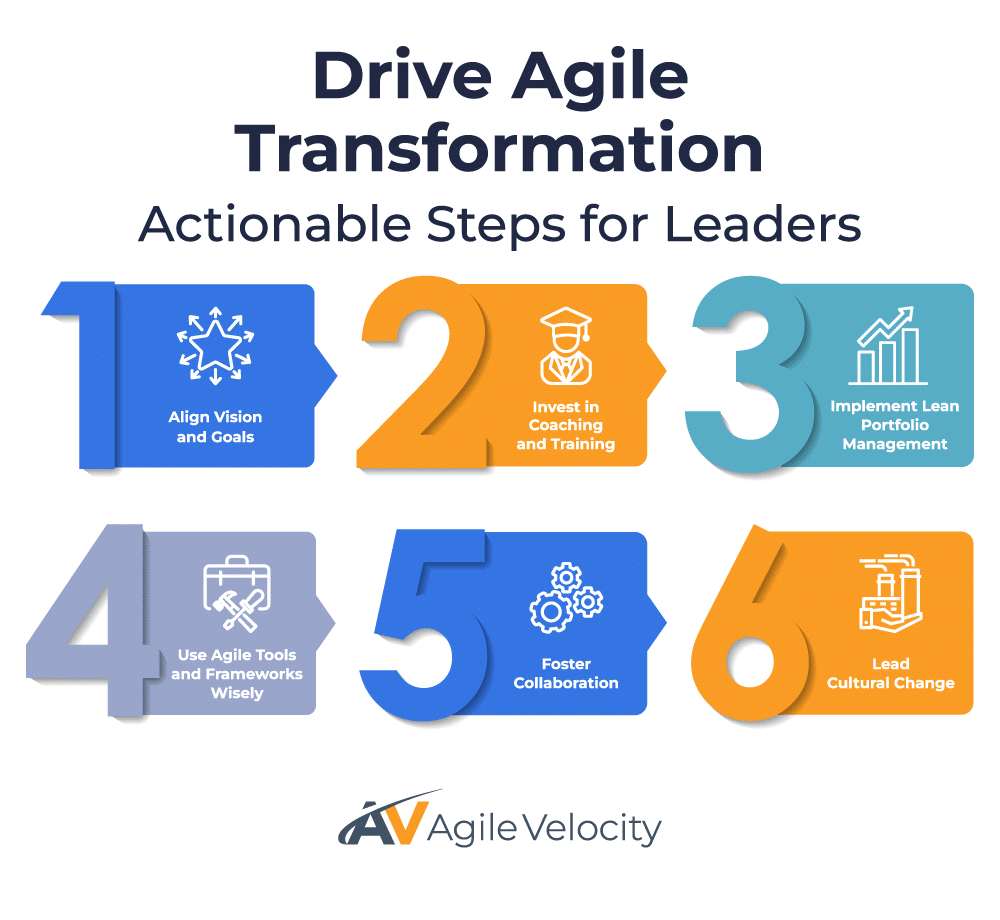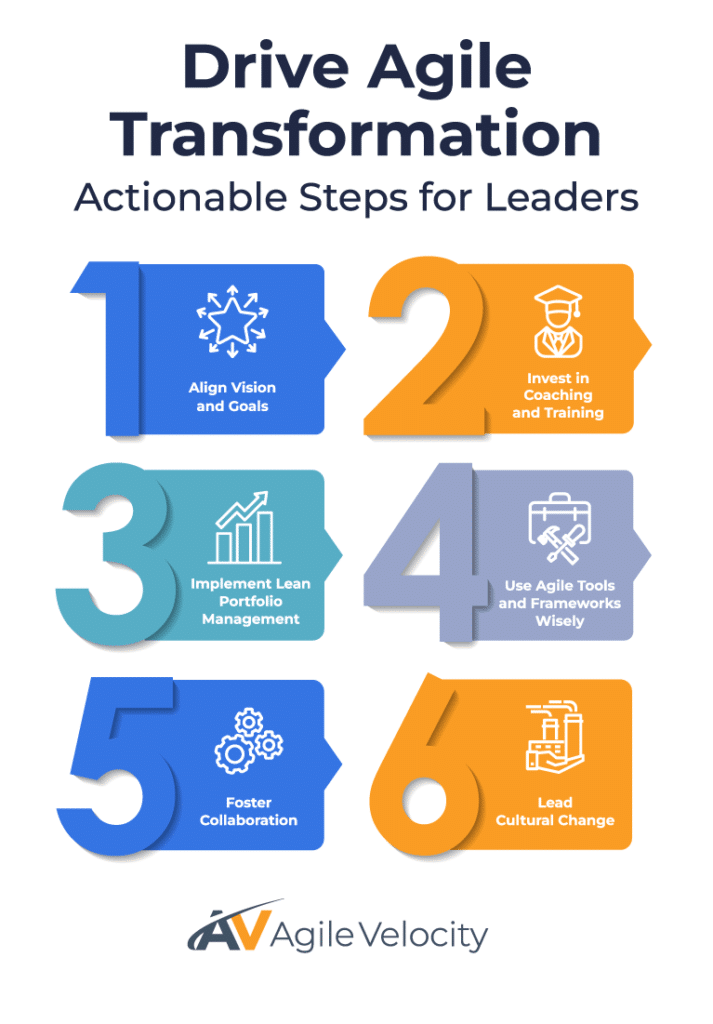For senior leaders navigating today’s fast-changing markets, Agile Transformation is essential for maintaining adaptability and delivering value at speed. It goes beyond simply adopting Agile practices—it requires a leadership mindset that promotes collaboration, customer-centricity, and continuous improvement across the entire organization.
Agile Transformation can empower businesses to accelerate value delivery and respond promptly to shifting market demands. However, achieving these outcomes hinges on visionary leadership that champions cultural change, aligns strategic objectives with Agile principles, and inspires teams to deliver meaningful results.
In this article, we’ll explore the core aspects of Agile Transformation from a senior leadership perspective, and highlight how consulting and coaching from Agile Velocity, coupled with the Path to Agility® Navigator can be invaluable for clarifying progress, pinpointing gaps, and helping to define next steps. By the end, you’ll have practical insights for embracing Agile Transformation and positioning your organization for long-term resilience and growth.
The Essentials of Agile Transformation
Agile Transformation reshapes how organizations work and deliver value. It requires fundamental shifts in mindset, structure, and leadership to keep up with evolving business landscapes.
The Core Principles of Agile Transformation
Agile Transformation rests on three guiding principles:
- Adaptability: Adjust quickly to evolving priorities rather than adhering to rigid long-term plans.
- Collaboration: Break down silos for open communication and shared goals, promoting alignment across teams.
- Customer Focus: Prioritize delivering frequent value to customers, ensuring feedback loops guide every product or service iteration.
Leaders who embrace these principles move beyond deadline-driven execution to fostering a culture of continuous learning and innovation. This allows the organization to adapt swiftly, capitalizing on new opportunities as they arise.
For further insights on supporting employees through these changes, see Leading Agile Change Management, which offers guidance on championing new ways of working.
Aligning Strategy with Agile Goals
To see lasting benefits, leadership must ensure Agile efforts serve overarching business objectives:
- Define Measurable Outcomes: Set clear targets—like faster releases or higher customer satisfaction—to guide transformation.
- Encourage Cross-Functional Teams: Whether using Scrum, Kanban, or other frameworks, bring diverse skill sets together for shared accountability.
- Champion Continuous Improvement: Establish a culture where experimentation and iterative learning are the norm.
Alignment between strategy and Agile practices ensures initiatives remain focused on delivering core business value. For more on broadening organizational adaptability, explore our guide on business agility.
Leadership, Culture, and Team Dynamics
Agile Transformation depends on a supportive leadership style, collaborative culture, and empowered teams:
- Servant Leadership: Effective servant leadership clears obstacles and empowers teams to thrive.
- Culture of Trust: Transparency and psychological safety encourage employees to share ideas and iterate fearlessly.
- Team Empowerment: Agile teams accelerate value by working in short cycles (such as Sprints or Iterations in SAFe®), fostering accountability and frequent feedback.
By modeling these traits, leaders signal their commitment to true organizational change.
Be the Leader Your Team Needs
Why Agile Transformation Matters for Technology-Driven Enterprises
Technology-driven organizations face relentless innovation cycles and shifting customer demands. Traditional methods fall short in today’s rapid innovation cycles – Agile Transformation provides a structured yet flexible approach to achieving::
- Rapid Response: With iterative workflows, teams can pivot as market shifts arise, using short feedback loops and empowered decision-making.
- Customer-Focused Delivery: Agile emphasizes customer needs by continuously reviewing and refining deliverables based on user feedback.
- Increased Engagement: Teams gain autonomy and clear purpose, fostering creativity and collaboration across the organization.
Additionally, frameworks like Large-Scale Scrum (LeSS) and subsequent implementations of SAFe coordinate multiple teams toward larger strategic goals.
Key Leadership Mindsets for Agile Transformation Success
Leaders guide the shift from static processes to adaptive ways of working by taking on crucial mindsets and behaviors.
Leaders as Enablers
- Define a Compelling Vision: Unite everyone around shared transformation goals.
- Lead with Emotional Intelligence: Understand how new processes affect teams, ensuring open dialogue around change.
- Empower Decision-Making: Push decisions closer to where the work happens, boosting innovation and accountability.
Servant Leadership in Action
Servant leadership removes roadblocks:
- Resource Provision: Invest in Agile Coaching and Agile Training so teams can adopt new ways of working effectively.
- Shield Teams From Distractions: Keep competing priorities at bay.
- Celebrate Progress: Recognize successes to maintain momentum and morale.
Promoting Psychological Safety
Encourage open communication and problem-solving without fear:
- Welcome Candid Feedback: Daily Scrums or planning sessions become key arenas for sharing status and challenges.
- Emphasize Team Success: Reward collaborative achievements over individual heroics.
- Build Trust: Foster an environment where risks and failures become opportunities for learning.
In addition, equipping teams with AI-driven capabilities in parallel is a great way to support continuous improvements in team performance.
How Path to Agility Navigator Supports Agile Transformation
Leading an Agile Transformation at scale can be complex. Path to Agility® Navigator provides structured guidance to keep organizations aligned and progress visible.
Creating a Clear Roadmap
Path to Agility Navigator identifies cultural and operational gaps:
- Identifying Key Transformation Areas: Leaders gain visibility into process inefficiencies, structural gaps, and cultural shifts needed for success.
- Tracking Progress: The tool visualizes transformation stages to keep everyone focused on business goals.
- Defining Next Steps: Clear insights show whether to invest in training, tackle impediments, or adjust resources.
Defining and Measuring Goals
Path to Agility Navigator emphasizes outcomes over process compliance:
- Strategic Objective Setting: Outline priorities like shorter release times or more predictable launches.
- Real-Time Metrics: Monitor deliveries, cycle times, and throughput to gauge effectiveness.
- Linking Efforts to Value: Align team outputs with broader organizational objectives, removing silos.
Request a Demo
Sustaining Agility
Path to Agility Navigator also helps maintain momentum:
- Continuous Improvement Focus: Guide long-term evolution as teams grow in maturity.
- Flexible Scaling: Adapt to expansions, additional teams, or broader Lean Portfolio Management needs.
- Data-Driven Leadership: Equip leaders with insights needed to adjust and sustain Agile practices over time.
Practical Steps for Leaders to Drive Agile Transformation
Senior leaders play a pivotal role in operationalizing Agile Transformation. Here’s how:


1. Align Vision and Goals
- Shared North Star: Communicate specific aims, like increased customer satisfaction or faster product launches, to unify the entire organization.
- Clarify Purpose: Demonstrate how Agile ties into planned outcomes, building buy-in at all levels.
2. Invest in Coaching and Training
- Accelerate Agile Adoption: Encourage official certifications, such as Certified Agile Leader or Certified ScrumMaster® (CSM®).
- Develop Internal Champions: Empower teams to learn, share best practices, and mentor each other on key Agile concepts.
- Invest in Coaching: Engage experienced coaches to provide personalized guidance and tailor strategies to your organization’s unique needs, ensuring a successful Agile Transformation.
3. Implement Lean Portfolio Management
- Focus on Strategic Outcomes: Allocate resources to initiatives that align directly with business goals.
- Maintain Transparency: Keep everyone informed about priorities and budgets.
- Adapt Rapidly: Revisit priorities as you glean new insights from stakeholders and evolving market data.
4. Use Agile Tools and Frameworks Wisely
- Scrum for Iterative Delivery: Employ Sprints and Sprint Retrospectives to deliver and learn swiftly.
- Kanban for Flow: Visualize progress, set Work In Progress (WIP) limits, and manage tasks efficiently.
- Scale with SAFe: For large enterprises, SAFe coordinates multiple teams toward unified objectives.
5. Foster Collaboration
- Cross-Functional Teams: Encourage diverse skills to converge and solve problems together.
- Regular Touchpoints: Short, focused sessions support alignment and shared accountability.
- Rotate Roles: Strategic role rotations build cross functional expertise and deepen organizational empathy.
6. Lead Cultural Change
- Frequent Communication: Use open forums or discussions on scaling Agile across multiple teams to update everyone on milestones and lessons learned.
- Recognize Early Wins: Reinforce positive outcomes that exemplify Agile values.
- Stay Attuned to Resistance: Address concerns directly, highlighting how new approaches benefit both employees and customers.
Common Pitfalls in Agile Transformation and Overcoming Them
Despite enthusiasm, organizations can stumble if they’re unprepared for typical challenges:
- One-Size-Fits-All Mindset
- Mix and match frameworks like Scrum, SAFe, or Large-Scale Scrum (LeSS) to fit different team needs.
- Tool-Focused Overhaul
- Balance new tools with cultural shifts. Emphasize agile mindsets during adoption to ensure lasting change.
- Unclear Purpose
- Clearly articulate Agile’s value proposition, linking transformation efforts directly to business goals and measurable outcomes.
- Excessive Reliance on Consultants
- Develop internal expertise so that once external consultants depart, teams can sustain their own progress.
- Loss of Momentum
- Celebrate incremental gains, and keep leadership visibly engaged to maintain enthusiasm.
- Ignoring Discomfort with Change
- Promote open conversations so teams feel supported, not forced, into new ways of working.
If silo-based mindsets persist, addressing a silo-based culture can further help leaders navigate the complexities of breaking departmental barriers.
Avoid Unnecessary Setbacks
Building a Culture of Continuous Improvement
Agile Transformation is an ongoing journey. Embedding continuous improvement ensures teams keep refining how they deliver value:
- Team Ownership: Decentralize decisions, celebrate initiative, and clarify how each person’s efforts impact organizational goals.
- Iterative Practices: Conduct regular Sprint Retrospectives to review learnings and adapt swiftly.
- Foster Innovation: Encourage experimentation, manage failure as a learning opportunity, and reward cross-team collaboration.
- Committed Leadership: Leaders should model growth, fund professional development, and review data to adjust strategies over time.
Sustaining agility hinges on integrating these practices into the organization’s core rhythm. An environment that prizes experimentation, learning, and adaptability will continue to thrive in the face of ongoing market changes.
Real-World Lessons for Senior Leaders
Senior leaders often discover that the shift to Agile is as much about personal mindset as it is about organizational processes. Successful and effective leaders prioritize removing roadblocks, ensuring teams can focus on delivering value rather than navigating bureaucratic hurdles. Instead of focusing solely on short-term gains, executives emphasize long-term cultural shifts, supporting collaboration through focused events and short planning sessions. This approach communicates that Agile is not a passing trend but a strategic priority with visible backing from senior management. Over time, employees adopt these new approaches with confidence, fueling rapid innovation in customer-facing initiatives.
For example, Texas Mutual Insurance took a targeted approach to Agile Transformation. Leaders there recognized that technical practices and new roles alone would not suffice. They invested in upskilling managers and Project Managers, enabling them to pivot from directing tasks to facilitating team decision-making. By adopting a transparent approach to progress tracking, the leadership team created a culture of shared responsibility. As a result, employees felt safe proposing improvements, and cross-functional collaboration became standard practice rather than an afterthought.
This real-world example highlights several key lessons for senior leaders:
- Visible Commitment: Transformations often stall when support from the top is not evident to those on the ground.
- Cultural Reinforcement: Sincere, consistent communication helps everyone understand why new processes matter.
- Team Empowerment: Clear objectives, autonomy, and open dialogue drive faster decisions and innovative thinking.
- Long-Term Perspective: Leaders who take the time to root Agile values into daily practices see more sustainable outcomes.
Build High-Performing Teams
At the same time, successful transformations do not happen overnight. Senior leaders can consider forming an internal community of practice composed of department heads, Scrum Master leads, and business sponsors. This forum acts as a sounding board for shared challenges and solutions, promoting better communication throughout the enterprise. By fostering cross-functional networks, leaders break down silos and cultivate a collective understanding of Agile’s benefits.
Leaders also find it beneficial to measure outcomes in stages. Specifically, dividing efforts into increments aligned with strategic topics—like speeding up release times, boosting product quality, or reducing rework—keeps the focus on tangible results. Stakeholders can see evidence of progress and use data to adjust priorities promptly. Encouraging pilot teams to run small experiments fosters a mindset of continuous learning and collaboration.
Finally, it is essential to remember that not all teams will move at the same pace. Some achieve early wins, while others need more time to adapt. This variance is natural in large-scale changes. Senior leaders who celebrate incremental successes, share lessons learned after setbacks, and maintain a steady focus on the broader vision demonstrate resilience and model the behavior they want teams to follow. By combining top-down guidance with bottom-up engagement, organizations can evolve in a way that sustains momentum and continues to deliver business value.
Strategic Vision: Leading Agile into the Future

Agile Transformation is more than a new process—it’s a mindset and culture shift that positions organizations to excel in unpredictable markets. By emphasizing collaboration, adaptability, and continuous improvement, senior leaders can unlock meaningful outcomes and align teams with strategic objectives.
Successful change starts with leadership. Model servant leadership, champion an environment of trust, and integrate tools like Path to Agility Navigator to track progress and define next steps. With consistent reinforcement and focus, your organization can stay ahead of emerging trends while continuously delivering customer value.
Ready to explore more about this journey? Contact Agile Velocity today to discuss your business needs and learn how our services can provide additional guidance on embracing sustainable agility.



